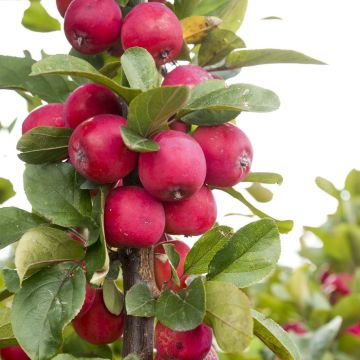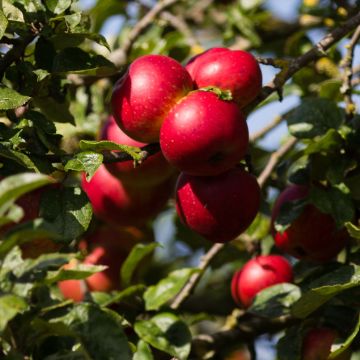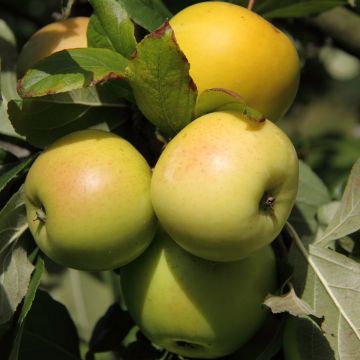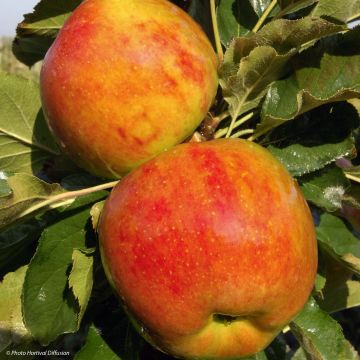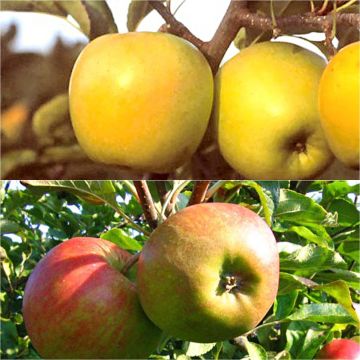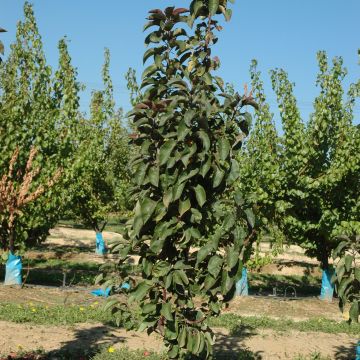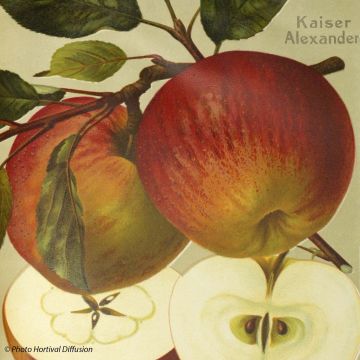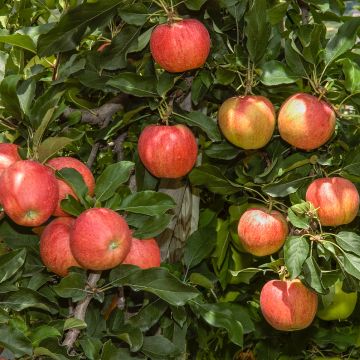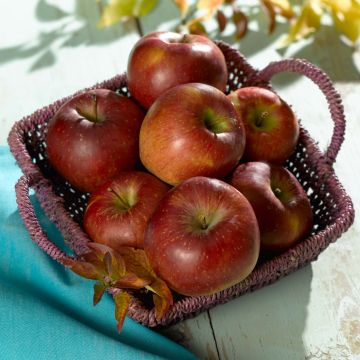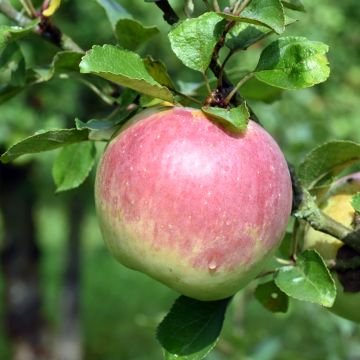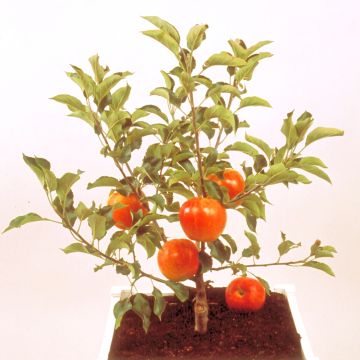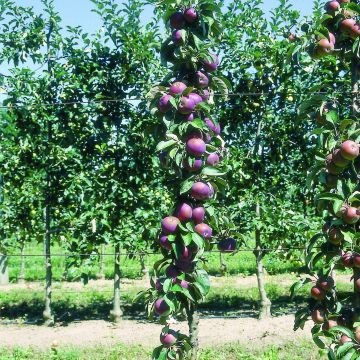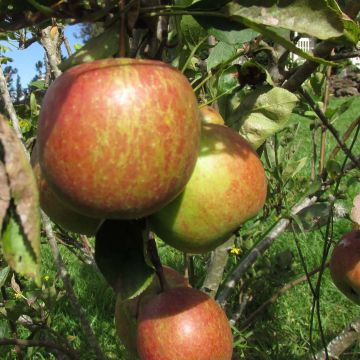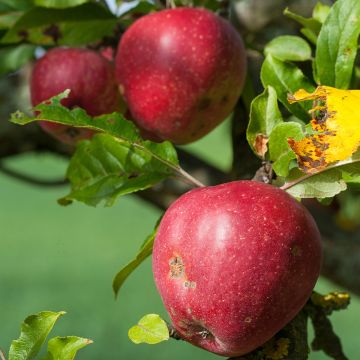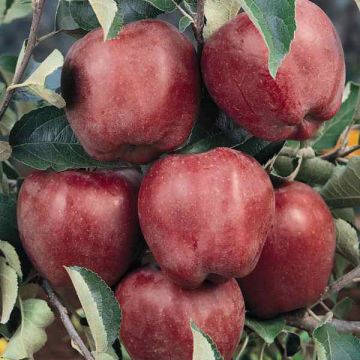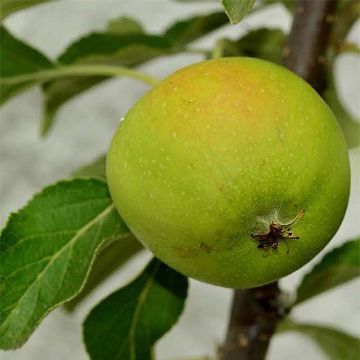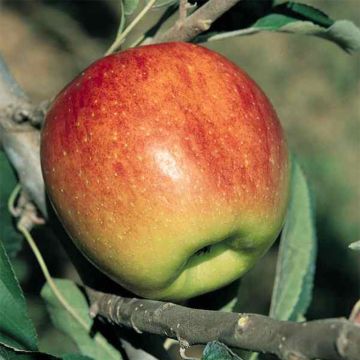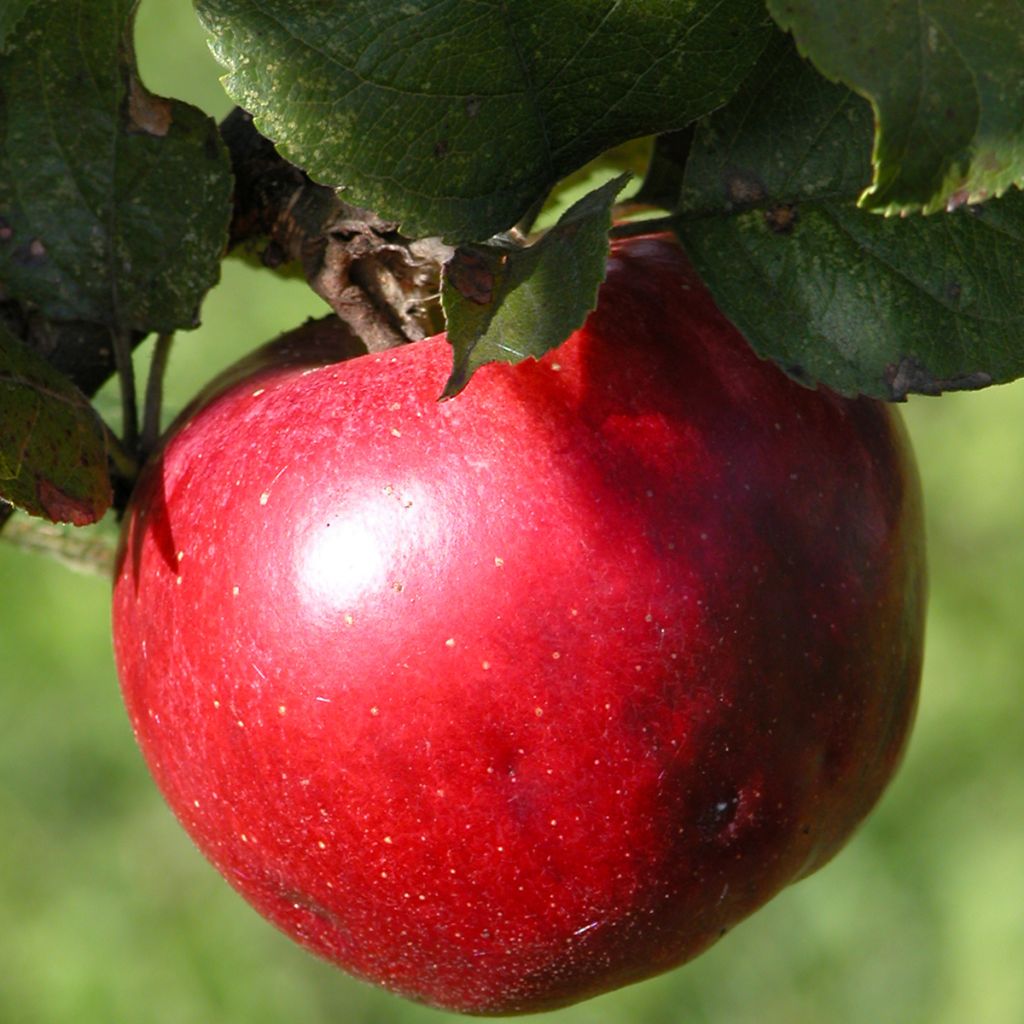

Malus Ballerina Red Leaf - Ballerina Apple Tree
Malus Ballerina Red Leaf - Ballerina Apple Tree
Malus ballerina Red Leaf
Ballerina Apple Tree
Why not try an alternative variety in stock?
View all →This item cannot be shipped to the selected country
Delivery charge from €5.90
More information
Schedule delivery date,
and select date in basket
This plant carries a 24 months recovery warranty
More information
We guarantee the quality of our plants for a full growing cycle, and will replace at our expense any plant that fails to recover under normal climatic and planting conditions.
From €5.90 for pickup delivery and €6.90 for home delivery
Express home delivery from €8.90.
Does this plant fit my garden?
Set up your Plantfit profile →
Description
The Malus domestica 'Red Leaf' will pleasantly surprise you with its many qualities. A self-fertile dwarf tree with a columnar habit is suitable for small gardens and can even be grown in a container on a terrace. A fruiting variety, it is also ornamental with its young reddish leaves in spring and its beautiful pale pink flowers. As they ripen, they develop into beautiful red apples with a highly developed aroma. They can be consumed as soon as they are harvested and also store very well. This small tree, which does not exceed 2m (7ft), is very hardy and grows well in soil that is not too alkaline or acidic and mainly not too dry. Plant it in a sunny location to promote fruit ripening.
The Malus domestica, also called Malus communis or Malus pumila over the centuries, is commonly known as the Common or Domestic Apple Tree. It belongs to the large family of Rosaceae, which includes many fruit species (Pear trees, Cherry trees, Peach trees), ornamental species (Roses, of course, Amelanchier, Kerria, Photinia), as well as small fruits (blackberries, raspberries, strawberries) and numerous wild species found in our countryside and forests. Present in France and Europe since ancient times, the Malus domestica is a fruit tree native to the forests of central Asia, probably from Kazakhstan. It is highly hardy and is likely the most cultivated fruit tree in Northern Europe. There are approximately 20,000 varieties, including around 10,000 of American origin, 2,000 of English origin, and 2,000 of Chinese origin.
'Red Leaf' is a distinctive columnar variety, forming a small tree that reaches a height of 1.50 to 2m (5 to 7ft) and a width of less than 1m (3ft). In spring, the emerging young foliage reveals a beautiful wine-coloured red, hence its name, Red Leaf. It gradually turns green during the growing season. In April, pink flower buds open into single flowers with pale pink petals until May, which generally protects them from frost. The flowers are indeed destroyed by frost from -2 to -3°C. However, the tree itself is very hardy and suitable for cultivation in all regions of France. Red Leaf is a self-fertile variety that does not require another tree nearby for pollination. The fertilised flowers develop into beautiful, shiny red apples, ripe in September-October. The flesh is highly aromatic and slightly acidic, and while they are delicious to eat when harvested, they also have good storage ability. They can be stored in a cool, dry place, away from light, around 8 to 10°C, or in a cold room, sealed off from outside air, at 1 to 3°C. Apples release ethylene, a gas that promotes fruit ripening. Place your apples next to them to accelerate the ripening of your other fruits or vegetables. Apples are a highly satiating fruit. Rich in carbohydrates and fructose, they are invigorating, energising, and hydrating. Their content of vitamins A, B, C, and E, minerals, antioxidants, and fibre make apples a healthy asset.
This variety is very hardy and will thrive in sunny exposures and most soils. However, it does not tolerate dry soils.
With its compact size, which allows it to be grown in any garden and even in a container on a terrace, Red Leaf is part of the dwarf fruit trees that will enable everyone to enjoy homegrown fruits. Treat yourself to a peach tree like Bonanza, a self-fertile variety that will delight you with its fruits from early August. The Garden Pearl Dwarf Pear Tree, with fruits as large as conventional varieties, will also be a good choice for your small orchard and the Goldust Dwarf Plum Tree, another dwarf fruit tree with yellow and sweet fruits.
Report an error about the product description
Malus Ballerina Red Leaf - Ballerina Apple Tree in pictures
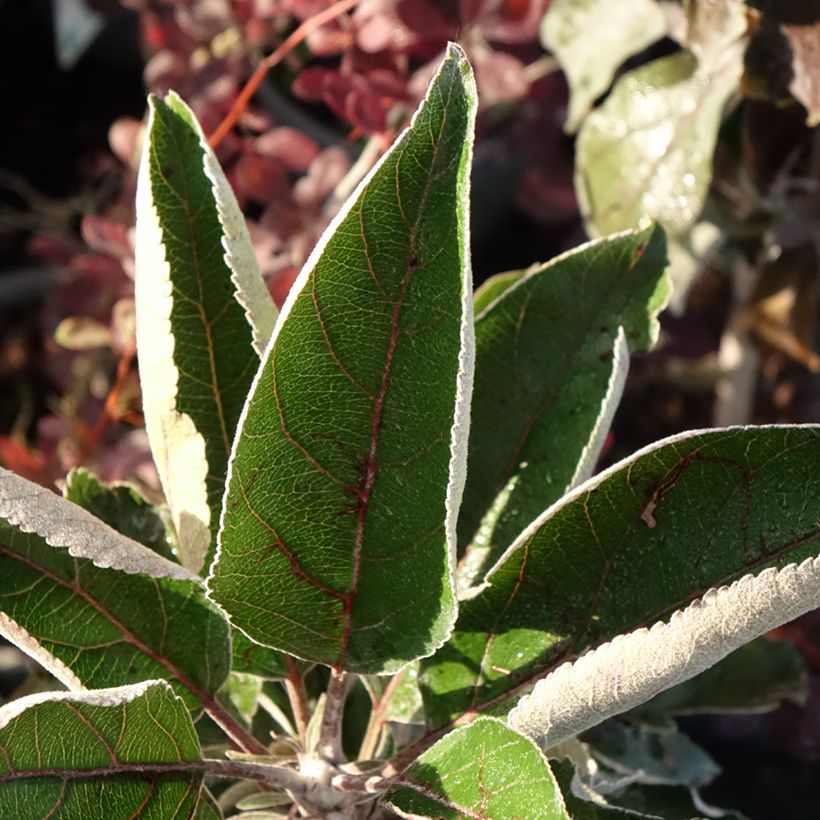

Plant habit
Flowering
Foliage
Botanical data
Malus
ballerina
Red Leaf
Rosaceae
Ballerina Apple Tree
Cultivar or hybrid
Other Apple trees
Planting and care
Choose a well-sunlit location for your 'Red Leaf' Columnar Apple tree; the soil can be slightly chalky or acidic but not excessively. Dig a wide planting hole at least three times the volume of the root ball. Simultaneously, organic matter (potting soil, compost, etc.) and a basal fertiliser such as bonemeal should be added. Do not bury the graft collar and stake if necessary. Water abundantly during planting, even in winter, and even if it rains. Fruit trees are ideally planted between October and March, outside of the freezing period. Container-grown plants can be grown year-round, except during high heat or frost periods.
The advantage of columnar fruit trees is that they can be planted in outdoor containers. Choose a container of at least 60L. Ensure the container is perforated and provides good drainage by filling the bottom with a thick clay pellets or gravel layer. In pots, your trees will naturally require more regular watering. In winter, move your fruit trees to a sheltered location away from the wind and stop watering during frost periods. Practice top-dressing at least every two years, which involves replacing the topsoil with fresh soil and fertilising before flowering; choose a special fertiliser with potassium, but not too rich in nitrogen.
During winter, it's recommended to add a small amount of wood ash, which is rich in potash, to the soil surface around the base of the tree to improve fruiting. To prevent diseases and pests from affecting apple trees, it's important to space them out sufficiently and plant diverse hedges, birdhouses or insect hotels to attract beneficial insects. It's best to prioritise diversity. The primary diseases that affect apple trees are scab (which causes brown spots on the leaves), brown rot (which results in wilting of flowers and rotting of fruits on the tree), and powdery mildew (which creates a white powdery coating on the leaves). To prevent diseases from attacking your plants, it's a good idea to spray them with a horsetail concoction. If the attack is severe, you can use a fungicide. The codling moth, also known as fruit worm, is a small caterpillar that creates galleries inside the fruit after the butterfly lays its eggs. To prevent this attack, you can promote the establishment of tits, mice, and bats by installing nest boxes. And if your plants are infested with aphids, spraying a solution based on black soap is an effective remedy.
Only keep the picked fruits during the September harvest. For good storage, place the apple with its stem downwards on racks or in crates. Choose a location that is preferably completely dark, dry, and cool but frost-free.
Planting period
Intended location
Care
This item has not been reviewed yet - be the first to leave a review about it.
Haven't found what you were looking for?
Hardiness is the lowest winter temperature a plant can endure without suffering serious damage or even dying. However, hardiness is affected by location (a sheltered area, such as a patio), protection (winter cover) and soil type (hardiness is improved by well-drained soil).

Photo Sharing Terms & Conditions
In order to encourage gardeners to interact and share their experiences, Promesse de fleurs offers various media enabling content to be uploaded onto its Site - in particular via the ‘Photo sharing’ module.
The User agrees to refrain from:
- Posting any content that is illegal, prejudicial, insulting, racist, inciteful to hatred, revisionist, contrary to public decency, that infringes on privacy or on the privacy rights of third parties, in particular the publicity rights of persons and goods, intellectual property rights, or the right to privacy.
- Submitting content on behalf of a third party;
- Impersonate the identity of a third party and/or publish any personal information about a third party;
In general, the User undertakes to refrain from any unethical behaviour.
All Content (in particular text, comments, files, images, photos, videos, creative works, etc.), which may be subject to property or intellectual property rights, image or other private rights, shall remain the property of the User, subject to the limited rights granted by the terms of the licence granted by Promesse de fleurs as stated below. Users are at liberty to publish or not to publish such Content on the Site, notably via the ‘Photo Sharing’ facility, and accept that this Content shall be made public and freely accessible, notably on the Internet.
Users further acknowledge, undertake to have ,and guarantee that they hold all necessary rights and permissions to publish such material on the Site, in particular with regard to the legislation in force pertaining to any privacy, property, intellectual property, image, or contractual rights, or rights of any other nature. By publishing such Content on the Site, Users acknowledge accepting full liability as publishers of the Content within the meaning of the law, and grant Promesse de fleurs, free of charge, an inclusive, worldwide licence for the said Content for the entire duration of its publication, including all reproduction, representation, up/downloading, displaying, performing, transmission, and storage rights.
Users also grant permission for their name to be linked to the Content and accept that this link may not always be made available.
By engaging in posting material, Users consent to their Content becoming automatically accessible on the Internet, in particular on other sites and/or blogs and/or web pages of the Promesse de fleurs site, including in particular social pages and the Promesse de fleurs catalogue.
Users may secure the removal of entrusted content free of charge by issuing a simple request via our contact form.
The flowering period indicated on our website applies to countries and regions located in USDA zone 8 (France, the United Kingdom, Ireland, the Netherlands, etc.)
It will vary according to where you live:
- In zones 9 to 10 (Italy, Spain, Greece, etc.), flowering will occur about 2 to 4 weeks earlier.
- In zones 6 to 7 (Germany, Poland, Slovenia, and lower mountainous regions), flowering will be delayed by 2 to 3 weeks.
- In zone 5 (Central Europe, Scandinavia), blooming will be delayed by 3 to 5 weeks.
In temperate climates, pruning of spring-flowering shrubs (forsythia, spireas, etc.) should be done just after flowering.
Pruning of summer-flowering shrubs (Indian Lilac, Perovskia, etc.) can be done in winter or spring.
In cold regions as well as with frost-sensitive plants, avoid pruning too early when severe frosts may still occur.
The planting period indicated on our website applies to countries and regions located in USDA zone 8 (France, United Kingdom, Ireland, Netherlands).
It will vary according to where you live:
- In Mediterranean zones (Marseille, Madrid, Milan, etc.), autumn and winter are the best planting periods.
- In continental zones (Strasbourg, Munich, Vienna, etc.), delay planting by 2 to 3 weeks in spring and bring it forward by 2 to 4 weeks in autumn.
- In mountainous regions (the Alps, Pyrenees, Carpathians, etc.), it is best to plant in late spring (May-June) or late summer (August-September).
The harvesting period indicated on our website applies to countries and regions in USDA zone 8 (France, England, Ireland, the Netherlands).
In colder areas (Scandinavia, Poland, Austria...) fruit and vegetable harvests are likely to be delayed by 3-4 weeks.
In warmer areas (Italy, Spain, Greece, etc.), harvesting will probably take place earlier, depending on weather conditions.
The sowing periods indicated on our website apply to countries and regions within USDA Zone 8 (France, UK, Ireland, Netherlands).
In colder areas (Scandinavia, Poland, Austria...), delay any outdoor sowing by 3-4 weeks, or sow under glass.
In warmer climes (Italy, Spain, Greece, etc.), bring outdoor sowing forward by a few weeks.

































